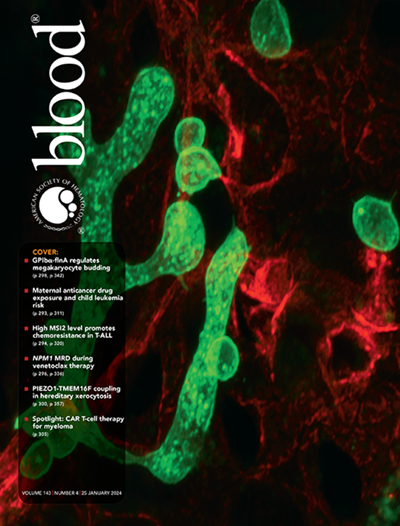我如何在TKI世界中处理CML的造血干细胞移植。
IF 21
1区 医学
Q1 HEMATOLOGY
引用次数: 0
摘要
随着酪氨酸激酶抑制剂(TKI)的引入,接受同种异体造血干细胞移植(alloo - hsct)治疗慢性期慢性髓性白血病(CP-CML)的患者数量急剧减少。伊马替尼是第一个被引入临床领域的TKI,主要用于一线环境。在反应不足、耐药或不耐受的情况下,CML患者随后可使用第二、第三或第四代TKI治疗。然而,尽管第一代、第二代、第三代、第四代TKI allo-HSCT获得批准,但仍有少数CML患者适用。在这里,我们通过不同的病例来讨论TKI时代的适应症,这些病例代表了同种异体造血干细胞移植仍然是最佳选择的临床情况。我们还提出了我们的移植策略,以降低移植相关的发病率,特别是移植物抗宿主病(GvHD),以及特定背景下CML(一种对免疫细胞治疗最敏感的疾病之一)的死亡率,允许使用供体淋巴细胞输注(DLI)和TKI相结合的移植后分子进展。本文章由计算机程序翻译,如有差异,请以英文原文为准。
How I approach hematopoietic stem cell transplantation for CML in a TKI world.
Following the introduction of tyrosine kinase inhibitors (TKI), the number of patients undergoing allogeneic hematopoietic stem cell transplantation (allo-HSCT) for chronic phase chronic myeloid leukemia (CP-CML) has dramatically decreased. Imatinib was the 1st TKI introduced into the clinical arena, predominantly utilized in the 1st line setting. In cases of insufficient response, resistance, or intolerance, CML patients can subsequently be treated with a 2nd, 3rdor 4th generation TKI. However, despite the approval of 1st, 2nd, 3rd, 4th generation TKI allo-HSCT still remains indicated for a minority of CML patients. Here, we discuss the indications in the era of TKI through different cases representing the clinical situations for which allo-HSCT remains the best option. We also propose our transplant strategy to decrease transplant-related morbidity, particularly graft-versus-host disease (GvHD), and mortality in the particular context of CML, a disease that is one of the most sensitive to immune cellular therapy, allowing the use of a combination of donor lymphocyte infusion (DLI) and TKI for post-transplant molecular progression.
求助全文
通过发布文献求助,成功后即可免费获取论文全文。
去求助
来源期刊

Blood
医学-血液学
CiteScore
23.60
自引率
3.90%
发文量
955
审稿时长
1 months
期刊介绍:
Blood, the official journal of the American Society of Hematology, published online and in print, provides an international forum for the publication of original articles describing basic laboratory, translational, and clinical investigations in hematology. Primary research articles will be published under the following scientific categories: Clinical Trials and Observations; Gene Therapy; Hematopoiesis and Stem Cells; Immunobiology and Immunotherapy scope; Myeloid Neoplasia; Lymphoid Neoplasia; Phagocytes, Granulocytes and Myelopoiesis; Platelets and Thrombopoiesis; Red Cells, Iron and Erythropoiesis; Thrombosis and Hemostasis; Transfusion Medicine; Transplantation; and Vascular Biology. Papers can be listed under more than one category as appropriate.
 求助内容:
求助内容: 应助结果提醒方式:
应助结果提醒方式:


